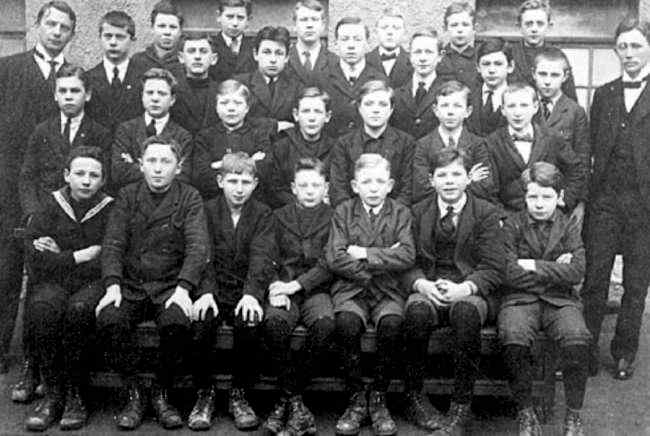
Unidentified German Secondary School (1915)

Figure 1.-- This class of younger German secondary school boys (aged about 13) is formally dressed for a their school portrait, but I believe this was standard school attire at the time. Most of the boys wear dark suits with formal white shirts and ties although a few do not abd a few wear sailor suits.
|
|
This class of German younger secondary school boys (aged about 13 years) is formally dressed for a school portrait. We think, however, this is how they normally dressed. Conventions at secondary schools tended to be formal. We are not sure just what kind of secondary school this was. Most of the boys wear dark suits with formal white shirts and ties although a few do not. Some of the boys wear sailor suits. This was a popular style for younger boys, but we also see younger teen-agers commonly wearing them in the 1910s. One boy in the front row (fourth from the left) also seems to be
wearing a type of sailor suit but without the stripes on the collar of his blouse. Note the vest of the boy in the first row (second from the right); he is obviously wearing a three-piece suit like that of his father except for the more juvenile knee trousers. One boy at the extreme right (first row) wears knickers that buckle below his knee. But knee pants seem to be the general rule in this school. All the boys wear long black stockings held up by hose supporters. You can see the garter clasps at the hem of the trousers on two of the boys in the front row (fourth from the left; second from the right). Many German boys held up their long stockings with a Leibchen and garter straps, although some older boys wore garter belts (similar to modern garter belts for hockey players). All the boys wear the standard hightop leather shoes that were standard wear for teenagers during the 1910s in Germany.
The School
We do not know the name of the school. We do know that it was a secondary school, but we do not know what kind.
Location
We do not know where in Germany this school was located.
Chronology
We do know that the portrait was taken in 1915. This was during World War I.
Class
This class of German younger secondary school boys. The boys look to be about 13 years old. There appear to be two teachers with the boys, one relatively young. The younger teacher on the right seems to have a monacle. I am not sure why there are two teachers. We suspect that the younger one was probbly drafted before the War ended.
Clothing
The boys are formally dressed for a school portrait. We think, however, this is how they normally dressed. Conventions at secondary schools tended to be formal.
Suits
Most of the boys wear dark suits with formal white shirts and ties although a few do not. Some of the boys wear sailor suits. This was a popular style for younger boys, but we also see younger teen-agers commonly wearing them in the 1910s. One boy in the front row (fourth from the left) also seems to be
wearing a type of sailor suit but without the stripes on the collar of his blouse. Note the vest of the boy in the first row (second from the right); he is obviously wearing a three-piece suit like that of his father except for the more juvenile knee trousers.
Pants
The boys seem to be mostly wearing knee pants, although we can not be sure about the boys in the back rows. One boy at the extreme right (first row) wears knickers that buckle below his knee.
Hosiery
All the boys wear long black stockings held up by hose supporters. You can see the garter clasps at the hem of the trousers on two of the boys in the front row (fourth from the left; second from the right). Many German boys held up their long stockings with a Leibchen and garter straps, although some older boys wore garter belts (similar to modern garter belts for hockey players). We note boys in primary schools wearing both socks and long stockings. Boys in secondary schools, even the younger boys, almost always wore long stockings.
Footwear
All the boys wear the standard hightop leather shoes that were standard wear for teenagers during the 1910s in Germany.
HBC-SU

Related Chronolgy Pages in the Boys' Historical Web Site
[Main Chronology Page]
[The 1850s]
[The 1860s]
[The 1870s]
[The 1880s]
[The 1890s]
[The 1900s]
[The 1910s]
Navigate the German school pages
[Return to the Main German 1910s individual school chronology page]
[Return to the Main German individual school chronology page]
[Return to the Main German school uniform page]
[Imperial Germany]
[Weimar Republic]
[NAZI era]
[Post-war Years]
[Modern Germany]
[Return to the Main school uniform page]
[Return to the Main school uniform national page]
Navigate the Relate Boys Historical Clothing Style Pages
[Main country page]
[Long pants suits]
[Short pants suits]
[Lederhosen]
[Kneesocks]
[Eton suits]
[Jacket and trousers]
[Blazer
[School sandals]
Navigate the Boys' Historical Clothing School Uniform Pages
[Main School Uniform Page]
[Australia]
[England]
[France]
[Germany]
[Italy]
[Japan]
[New Zealand]
[Scotland]
[United States]
Navigate the Boys' Historical Clothing Web Page
[Introduction]
[Activities]
[Biographies]
[Chronology]
[Clothing styles]
[Countries]
[Bibliographies]
[Contributions]
[FAQs]
[German glossary]
[Images]
[Links]
[Registration]
[Boys' Clothing Home]
Created: 4:23 PM 5/30/2007
Last updated: 4:23 PM 5/30/2007




